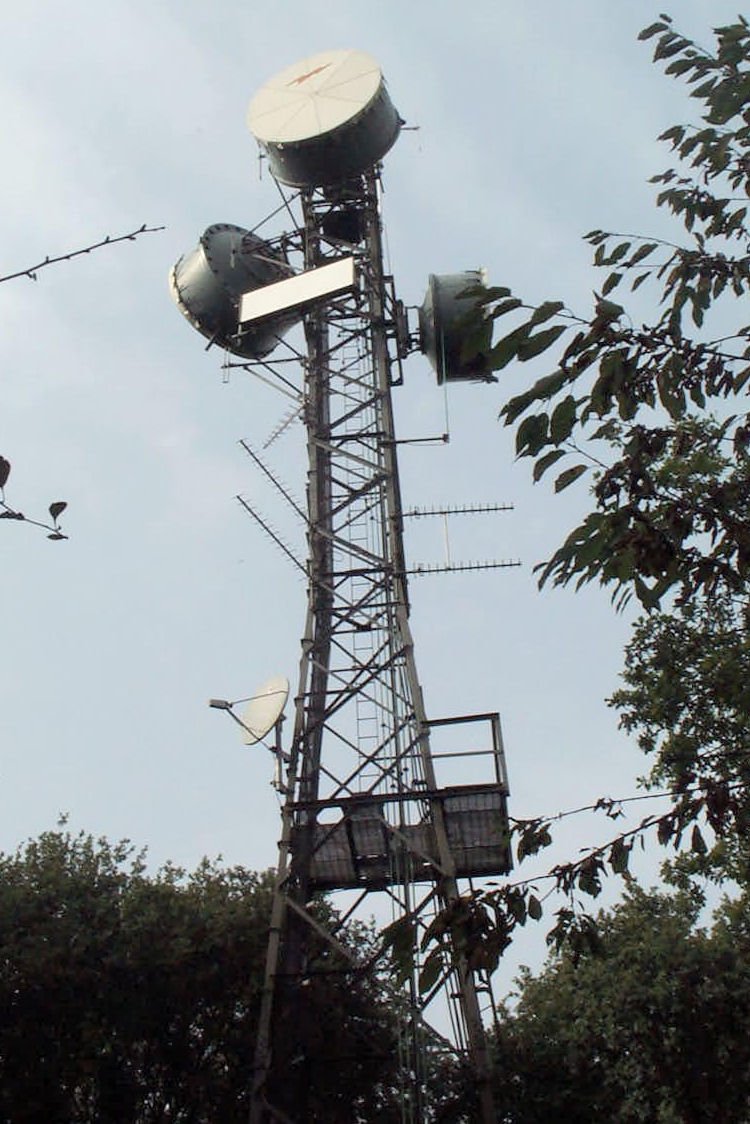 |
UK Broadcast Transmission |
|
|||||||||||
THE TRANSMISSION GALLERY
| Photos by WPO | Page last updated: 2020-03-26 |
|
||||||||||||||||||||
| Distribution of stereo programming from the studio to the transmitter requires both audio channels be identically matched so that the highest possible reproduction of the stereo image can be achieved. Today the distribution of programmes to the transmitters is normally done digitally with both channels encoded and decoded at the same time and taking the same route between the studio to the transmitter via reasonably high quality SHF links and fibre optic cables. In the 1960s the BBC distributed stereo programmes via a method which made use of receiver sites with SHF links with non-demodulating repeaters, as shown in picture 1 below. This method of distributing stereo signals as received at Whipsnade from Wrotham would allow listeners in the Midlands and the North via Holme Moss to receive stereo programmes, but this was a limited service which would only benefit Radio 3 listeners. Eventually a better solution was found which allowed a much larger population to be provided with stereo reception across all BBC radio services, instead of the service being limited to listeners of Radio 3 in South East, Midlands and North of England. The BBC developed 13 channel PCM in the early 1970s which distributed all the BBC national radio services in one large digital multiplex and therefore provided the main transmitters with identical very high quality audio channels, which would be used to provide high quality stereo FM services for all BBC networks. The system was also used for distribution of medium wave services around the country. Whipsnade formed a major part of this network along with Macclesfield Forest, and Meriden between Whipsnade and Sutton Coldfield. Whichford was dropped in favour of Thorpe Lodge, and Tick Hill was added between Sutton Coldfield and Macclesfield Forest. The PCM distribution was further extended in 1980 with an additional link, via Sandy Heath, onwards to Peterborough and Tacolneston. Eventually technology progressed again and the old 13 channel PCM system was replaced by the PCM/NICAM standard which allowed even more high quality audio channels to be sent around the country alongside other BBC in house services and DAB. Whipsnade would be part of this network with Swains Lane in London. In the 1990's the BBC NICAM distribution was changed to fibre optic circuits provided by Energis, but the SHF feed to Sandy Heath, and onwards to Peterborough and Tacolneston remained. This SHF feed was decommissioned in 2016 when the NICAM feeds to Peterborough and Tacolneston were changed to BT provided MPLS circuits. Whipsnade at one time provided the main feed for BBC2 to Sandy Heath by receiving the service off air from Crystal Palace and relaying it onwards to Sandy by SHF link. This RBL was in use from the opening of BBC2 from Sandy in 1969 until regional opt-outs were introduced to the service in the late 1980's, at which point the route was demoted to RBS (rebroadcast standby) as Sandy Heath was assigned to the BBC East region from Norwich. Whipsnade also provided the feeds for both BBC1 and BBC2 to Oxford until that transmitter was transferred to the BBC South region. Whipsnade was also considered as one of the original two VHF radio sites for BBC R Bedfordshire (now 3CR) but in the end this never happened and the station co-sited with ILR at Zouches Farm. There are no broadcast services transmitted from this site but it is a historically interesting site nonetheless. |

| Technical layout of the Radio 3 FM distribution system in February 1969. All Radio 3 programmes fed to Wrotham are via two matched GPO lines from Broadcasting House. Wrotham Radio 3 transmission is received off air at Whipsnade using a double-superheterodyne receiver with a 1 MHz IF output. Similar equipment was located at Macclesfield Forest for reception of Sutton Coldfield. |


| The trough antenna is on Crystal Palace which provided the programme feeds for both the SHF links to Oxford and Sandy Heath. No longer used since DSO. The SHF antenna at the top is facing Swains Lane. Left Oxford. Right Sandy Heath. |

Crystal Palace | Oxford | Sandy Heath | Swains Lane | Thorpe Lodge (link site)
Pulse code modulation for HQ sound
Progress in the Use of Pulse-code Modulation for High-quality Sound Links
BBC 13 Channel PCM System
| |
Back to TX Gallery index | TX main index
|